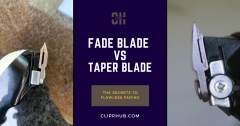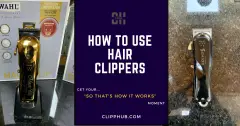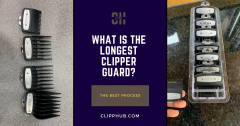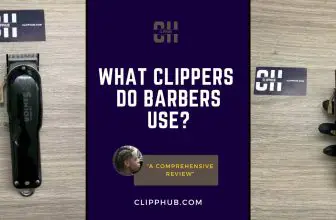
So you’ve got some clippers and guards and as you look at both? You ask yourself, how do clipper guards work?
It’s a common question and in this article, you’ll learn all you need.
We’ll run through what lengths different guards cut to, you’ll learn how do you use them to fade?
And… you’ll learn about the different types of guards readily used by most clipper owners.
So, with that said, let’s get into it.
How Do Hair Clipper Guards Work?
To understand the cutting length of your clipper guards, you need to know what blade you have and what length they cut to.
On your clipper, you’ll have a tapered blade or a fade blade:

Each has varying cutting lengths but to summarise, a fade blade clipper will cut closer to the skin than a fade blade.
And while both will cut to around the same length, a tapered blade is a bit more forgiving.
You can read more on this in our article on fade blades vs taper blades:
Fade Blade vs Taper Blade (Battle of Blades)
But so you don’t confused, I’m going to assume these factors:
- Fade blade clipper (most commonly found on clippers).
- Clipper closed cuts to 0mm.
- Clipper open cuts to 1.5mm
This will make it easier for you to understand + it’s a common clipper setup.
Lets’s begin with wahl guards for example:
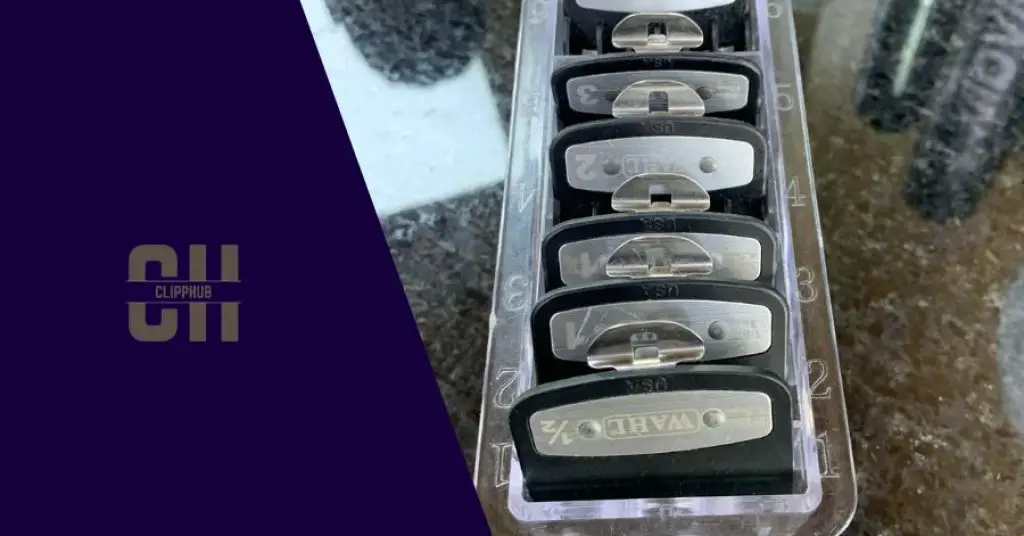
Clipper Guard Size Chart

Hair Clipper Guards Explained
If you had a #1 guard (3mm) with the lever closed (0mm) it will cut to that exact length of hair which is 3mm.
But if you had a 1 guard (3mm) with the clipper lever open (1.5mm), it now moves up to become 1 ½ = 4.5mm
Similarly, if you had a 1 ½ guard (4.5mm), lever open(1.5mm) it becomes a #2 guard (6mm).
But if you were to go from a 1 ½ guard (4.5mm)and the lever is closed (0mm) then you have the true cutting length of the guard which is just 1 ½ (4.5mm).
This is a quick overview of how clipper guards and clipper levers work together.
Later in this guide, I’ll show you what can to use to blend. But first, how do guards actually work? I explain next.
Do clipper guards prevent cuts?
Yes, basically that’s what clipper guards do.
Clipper guards give you a buffer and stop you from cutting more hair than you need.
When your lever is closed, your guard will let your cut to the length stated on the guard.
That’s what you need to keep in mind.
When you look at your clipper guards it may be scary but in reality, you may not need to use all of them, unless you looking to have a really long haircut.
If you’re looking to get fade for example, you should only really be looking at the guard that gives you the longest length of hair all the way down to shorter guards which you’ll be using to blend.
Now that you know which guards you’ll be using, there’s also another important part of your clipper that you need to get the hang of, and that would be your lever.
How Do Guards on Clippers Work?
Now you must understand your clipper lever as they work together.
Both your clipper guard and your clipper lever work together.
Let’s start with the lever up
This is an image of the lever-up:
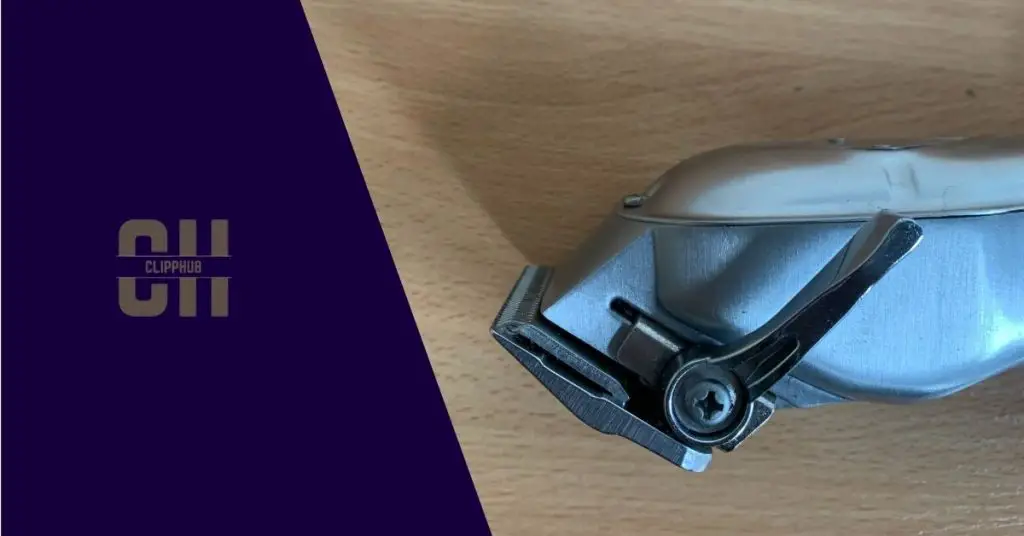
This is also known as the lever closed and this will cut more hair.
On the other hand, this image shows the blade down:

This will cut less hair and the lever is open.
So, the bigger the guard, the less hair you cut.
But also, with your lever closed, your will cut less hair.
When cutting hair you can use a combination of both in order to get the cleanest fade possible.
Let’s start at the blade levers once again.
How Do Guards Work on Clippers
With no guard, as you move a clipper blade between open and closed you are basically cutting more (closed) or cutting less (open) by 1.5 mm, (1/16 inch.) – on average.
But what does that mean exactly? Let’s take a look:
For example, let’s say you had a 1 guard and your clipper lever is ‘closed’, as you open up your lever to ‘open’ your clipper now becomes a 1 ½.

So now, let’s say you had hair that was 3mm long, the same as a 1 guard. The hair below it is slightly shorter which creates a natural guideline (hair at two different lengths).
One hair level is at a #1 guard length (3mm) and the other is at a #0.5 guard length(1.5mm), below.
What you can do is, with the guard, half guard lever ‘open’(same as 3mm), start on that 3 mm guideline and move down through the 1.5mm hair level (but as you go through the hair begin to slowly move the lever to “closed”.
By the time you reach the bottom of the 1.5mm guideline, you will be at a half guard ‘lever closed’ which is the same length as the bald line below it (1.5mm – same as lever open). Meaning those two lengths blend into each other.
That’s how you knock out guidelines and fade.
You can read more about this process in our guide on how to use clipper guards.
How to Use Hair Clippers (Use Clippers Like A Pro)
Now you don’t have to move your clippers in tiny increments.
You can move your lever halfway and still almost get the same effect.
Professionals look for a precise cut do little increments and adjust all over the place.
But as you start, it can be difficult and complicated, start halfway and as you get more confident, move in smaller increments.
Now the lengths I just showed you are only a small amount of possible clipper lengths,
I’ll go through some more of the most popular clipper brands in my guide on the longest clipper guards:
What Is the Longest Clipper Guard? (All You Need to Know)
Types of Clipper Guards
Each brand has its own clipper guard.
Some include some guard lengths while others didn’t take a look at the chart below for wahl and Andis and detachable blades.
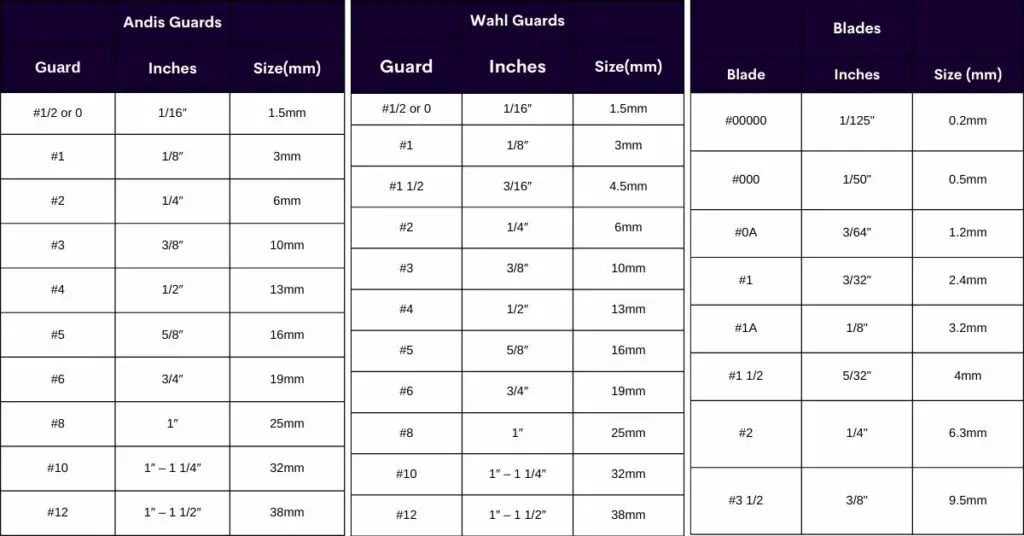
Detachable blade clippers don’t have a lever.
They cut that length and that’s it.
Let’s say you are a length #3 (9.5 mm) detachable clipper. No matter what you do, it will only cut that length and it doesn’t have a lever at all.
Also, notice how at the shorter lengths on detachable, you can get very detailed about how much hair you cut off.
This is probably the reason why barbers prefer blades the detail is there but if you can’t be bothered to keep changing out your blades, then a lever-based clipper can work for you too.
Andis (magnetic guards) doesn’t make a 1 and a half so to compensate for this, you can do a #2 guard with your clippers closed, and that can work as your 1 ½.
Keeping the brand of your clipper to the brand of your blades is important, I explain further below.
Factors to Consider When Choosing a Clipper Guard
Clipper guards cut to the same length but sometimes that’s not the case.
Take for example the andis magnetic guards and wahl clipper premium clipper guards.
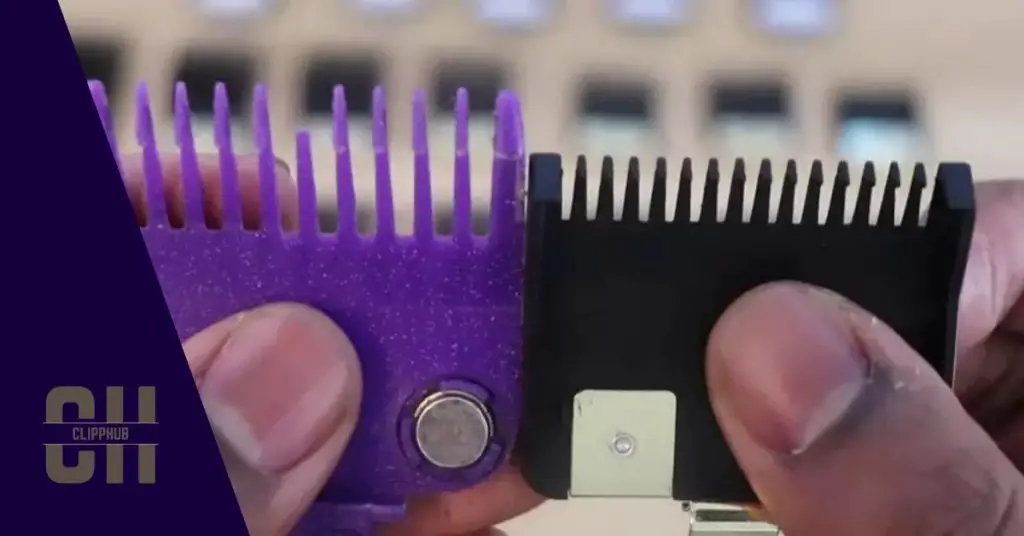
There’s a difference in the teeth size.
The Andis magnetic guards’ teeth are larger while the teeth on the Wahl premium guards are much finer
So when cutting, you’ll get slightly more length with the Andis guard than you would with the wahl premium guards.
That’s not a bad thing, it means the andis guard can feed more hair into your clipper to be cut as the teeth are longer.
while the wahl guard cut hair more finely.
This goes the same for the blades as well. The guard blade on andis clippers is longer while the guard blade on wahl clippers is shorter and finer.
So overall, the wahl premium guard for example will cut true to length while the andis magnetic guard leaves a little more hair than what is stated on the guard.
This is why you should be careful when using a certain brand of guard on another brand of clipper.
Not only are the blades different but the guards are slightly different too.
Check out our article on the longest clipper guards for the length of other brands.
Conclusion
At the start of this guide, we asked the question how do clipper guards work?
You should now have an understanding and be able to use the knowledge to give yourself a better cut.
If you found the Thai article helpful, check out another article about this article below.

